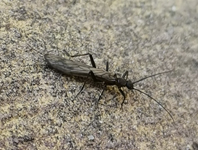Abstract
The spider genus Macrophyes O. Pickard-Cambridge, 1893 includes five species from the Neotropical region (World Spider Catalog 2019). Two species were described from Central America, M. attenuata, the type species, by Pickard-Cambridge (1893), known until now only by the male, and M. elongata by Chickering (1937) know by both sexes. Three other species were described from South America, M. silvae Brescovit, 1992 and M. manati Brescovit, 1993 from Peru, and M. jundiai Brescovit, 1993 from Brazil (Brescovit 1992, 1993). Brescovit (1997) diagnosed this genus from other Anyphaeninae by the cylindrical abdomen, retrolateral margin of the chelicera with prominent distal tooth, close to the claw and by the tibia of the male palp almost twice longer than the cymbium. The females could be confused with Mesilla Simon by the long and cylindrical abdomen, but are distinguished by the epigynum with narrow, sinuous lateral borders and, internally, by the long copulatory ducts (see Brescovit, 1997: figs 146, 150−151).
References
Brescovit, A.D. (1992) Revisão das aranhas do gênero Macrophyes O. Pickard-Cambridge, da região Neotropical (Araneae, Anyphaenidae). Revista Brasileira de Entomologia, 36, 101−106.
https://doi.org/10.1590/S0101-81751996000500001
Brescovit, A.D. (1993) Novas espécies do gênero Macrophyes O. P.-Cambridge da região Neotropical (Araneae, Anyphaenidae). Iheringia, 75, 113−116.
https://doi.org/10.1590/S0101-81751996000500001
Brescovit, A.D. (1997) Revisão de Anyphaeninae Bertkau a nível de gêneros na região Neotropical (Araneae, Anyphaenidae). Revista Brasileira de Zoologia, 13, 1–187.
https://doi.org/10.1590/S0101-81751996000500001
Chickering, A.M. (1937) Anyphaenidae of Barro Colorado Island, Panama Canal Zone. Papers of the Michigan Academy of Science, Arts and Letters, 22, 541−561.
Cooke M.C. (1892) Vegetable wasps and plant worms: a popular history of entomogenous fungi, or fungi parasitic upon insects. Society for Promoting Christian Knowledge, London, 364 pp.
https://doi.org/10.5962/bhl.title.34922
Evans, H.C. (2013) Fungal Pathogens of Spiders. In: Nentwig, W. (Ed.), Spider Ecophysiology. Springer, London, pp. 107−121.
https://doi.org/10.1007/978-3-642-33989-9_9
Evans, H.C. & Samson, R.A. (1987) Fungal pathogens of spiders. Mycologist, 1 (4), 152−159.
https://doi.org/10.1016/S0269-915X(87)80107-6
Humber, R.A. & Rombach, M.C. (1987) Torrubiella ratticaudata sp. nov. (Pyrenomycetes: Clavicipitales) and other fungi from spiders on the Solomon Islands. Mycologia, 79, 375−382.
https://doi.org/10.1007/s11557-018-1431-4
Oliveira, T.S.D. &, Araújo, F.S. (2007) Diversidade e conservação da biota na Serra de Baturité, Ceará. Edições UFC, COELCE, Fortaleza, 465 pp.
Kobayasi, Y. & Shimizu, D. (1977) Some species of Cordyceps and its allies on spiders. Kew Bulletin, 31 (3), 557−566.
https://doi.org/10.2307/4119402
Pickard-Cambridge, O. (1893) Arachnida. Araneida. In: Biologia Centrali-Americana, Zoology, London, 1, 105−120.
Samson, R.A. & Evans, H.C. (1973) Notes on Entomogenous Fungi From Ghana: I. The Genera Gibellula and Pseudogibellula. Acta Botanica Neerlandica, 22 (5), 522−528.
https://doi.org/10.1111/j.1438-8677.1973.tb00873.x
Samson, R.A. & Evans, H.C. (1992) New species of Gibellula on spiders (Araneida) from South America. Mycologia, 83, 300−314.
https://doi.org/10.1080/00275514.1992.12026143
Sánchez-Peña, S.R. (1990) Some insect and spider pathogenic fungi from Mexico with data on their host ranges. The Florida Entomologist, 73 (3), 517−522.
https://doi.org/10.2307/3495473
Strongman, D.B. (1991) Gibellula pulchra from a spider (Salticidae) in Nova Scotia, Canada. Mycologia, 83 (6), 816−817.
https://doi.org/10.1080/00275514.1991.12026087
Tzean, S.S., Hsieh, L.S. & Wu, W.J. (1997) The genus Gibellula on spiders from Taiwan. Mycologia, 89, 309−318.
https://doi.org/10.1080/00275514.1997.12026787
World Spider Catalog (2019) World Spider Catalog, version 20.0. Natural History Museum Bern.

